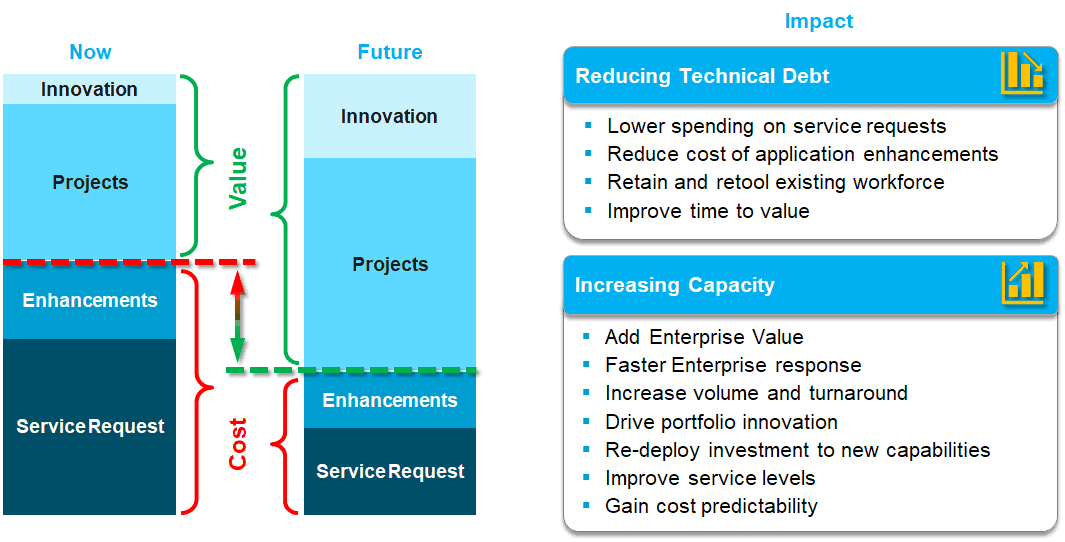 Today’s Competition Is Driving a Change
Today’s Competition Is Driving a Change
As part of our guidebook series (at the end of this post) on successful digital transformation, we are moving from what digital is to how you should execute a digital program. When considering limited resource capacity, budget constraints, and uncertain markets, you should start your digital journey by reducing costs through simplifying and modernizing the IT landscape. The business need for simplification and modernization is about remaining viable in volatile or competitive markets.
A significant amount of research shows that the lifecycle for business is continuously getting shorter. The “33-year average tenure of companies on the S&P 500 in 1964 narrowed to 24 years by 2016 and is forecast to shrink to just 12 years by 2027.” The companies and organizations that survive, and in some cases even thrive in this environment, are the ones with a strong emphasis on their customers, or “need seeker” type enterprises. Today’s business environment requires a nimble business and marketplace agility combined with customer engaging technologies. Simplifying your landscape helps improve some of that marketplace agility.
Simplification Reduces Costs and Recaptures Capacity
Technology complexity limits your IT organization’s ability to execute on Digital (focus on customers and markets). That complexity is costing your organization the ability to deploy the right technology solutions at a reasonable price and in a reasonable time frame. Many new technology solutions integrate your organization with your customers and markets, allowing you to take advantage of new channels or address competitive pressures. Older technologies and complex integration create speed bumps or even road blocks:
- outdated point solutions,
- multiple integration tools and methods,
- fragmented stacks,
- inconsistent or duplicated master data,
- a disconnected user experience,
- captured support resource capacity (that could be redeployed for value),
- and a web of complexity.
As our illustrations demonstrate in How to Free Up Capital and Capacity for Digital Transformation, there is a clear business case for simplifying and modernizing to reduce cost and improve agility. A Harvard Business Review study, “The Business Case for Managing Complexity” (2015), provided the insight of 749 business leaders. That study made the following findings:
“86% determined complexity is hindering their growth.
Almost half say their IT systems cannot respond quickly enough to deliver innovative business models or processes.
Those companies with a management emphasis on complexity management “report having faster-responding IT systems and more engaged, proactive IT departments.
Complexity creates a “tax on innovation” so that “only 11 percent of respondents felt their organization is a top innovator in their sector, and that only a quarter of the best-in-class respondents felt they were top performers in their ability to innovate.”
The Impacts of Simplifying and Modernizing while Reducing Technical Debt
The majority of ERP legacy systems are over ten years old, precede current e-commerce and mobility systems, and cannot stay up to date with the digital economy. Some key features affecting digital disruption include the following:
- The digital economy’s Social, Mobile, Analytics, and Cloud (SMAC) platforms have increased customer expectations of responsiveness, quality, and innovation.
- To remain competitive in today’s marketplace, organizations must continually innovate and introduce complementary or new services and products, just to keep up with disruptive marketplace changes that the digital economy requires.
- Legacy ERP systems have too much technical debt, consisting of complicated integration, overly engineered customizations, and bloated application portfolios with high upkeep, hardware, and software costs (i.e. the technical debt burden). A lot of these systems are out of date and unable to satisfy new digital service requirements.
- Technology needs to be elastic, scalable, agile, and flexible to reduce hardware constraints. This has given rise to Infrastructure-as-a-Service (IaaS) in place of on-premise data centers or hardware. Cloud hosting capabilities are becoming a technology equalizer supporting greater digital business competition and marketplace disruption.
- Newer disruptive technologies such as Machine Learning, Artificial Intelligence, and the Internet of Things are barely possible in many technical debt laden legacy environments. When they are possible, existing technical debt compounds the cost of adding application and integration layers.
- Together with these challenges, businesses need to accommodate the mobile phone and social media populations. Apps are everywhere and have created a consumer mindset of anywhere, anytime, and easy to use.
Technical debt in today’s systems often reflects design decisions and business requests. Many poor design decisions arise from the haste to complete projects on time, or the unfamiliarity with the full capabilities of the software being used. Short-term technical debt may seem like an advantage, but when stacked together with other solutions and customizations over time, it takes on a life of its own. Continuing to feed and maintain that technical debt burden creates a vicious cycle of a larger and larger debt to overcome until it becomes an insurmountable mountain of cost.
Today’s business environment requires a nimble business and marketplace agility, combined with customer-engaging technologies.
By focusing on simplifying, modernizing, and managing your technical debt, you quickly free up capital and capacity as you move to a more nimble or agile future.
Remove constraints to flexibility, agility, and the development of elastic capabilities.






